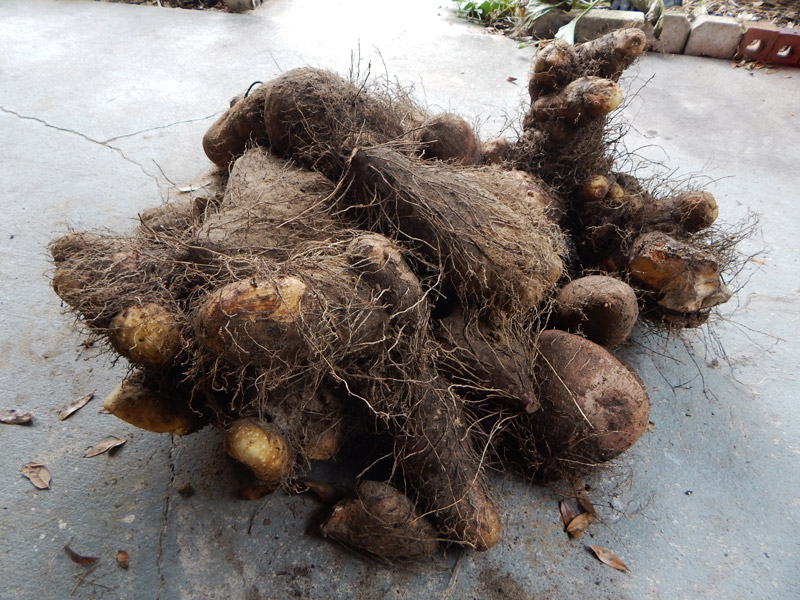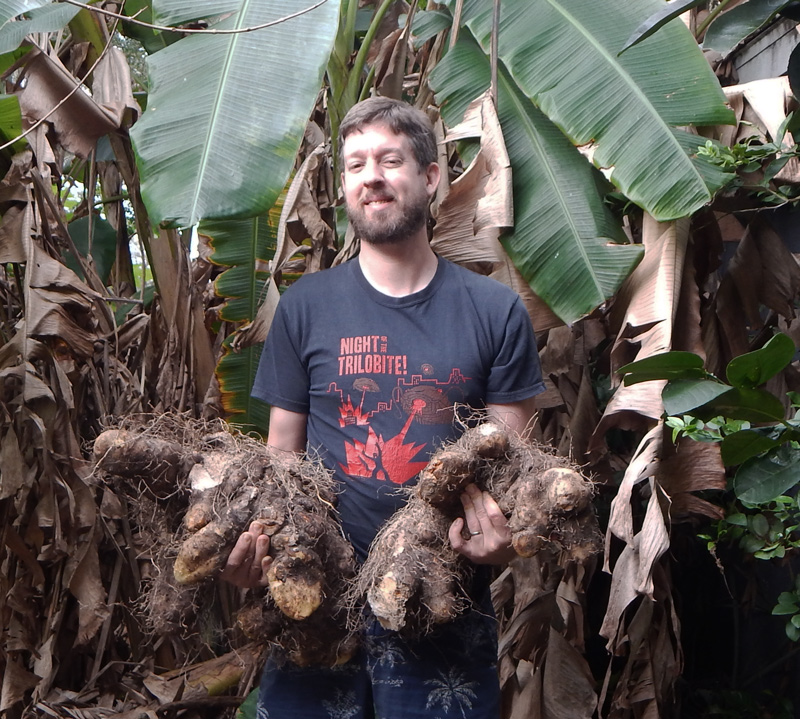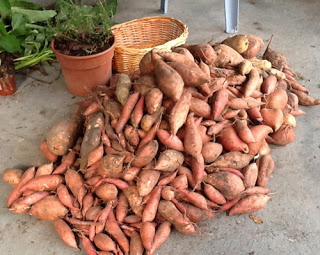I spent Christmas morning (after exchanging presents with the children) digging up huge yams in my yard.
Merry Christmas to ME!

It may be hard to tell thanks to the strange perspective, but that’s around 140lbs of yams.
True yams, not to be confused with sweet potatoes, are the simplest root crop you can grow in Florida.
They taste like white potatoes and both fry nicely and are a good addition to soups.
Most of these yams grew in the “wild” parts of my yard beneath trees and along fences.
How To Grow Huge Yams
Growing huge yams, as opposed to normal-sized yams, is just a matter of letting them stay in the ground for an additional year.
My largest one is a 2-3 year old root that clocked in at 45lbs.

That was a single root that broke in half. It took me about a half hour to dig it up, then pulling it from the ground was a chore.
I ate some yam hash browns for breakfast. I didn’t water or fertilize those vines and I got huge yams in two years just by waiting around.
You can’t do that with white potatoes!
Here’s how I took some yams from the store and grew them out for the garden this spring.
If you plant your yams in a nice, fertile spot with good water, they’ll grow even faster. I got a 10lb root from one of those “minisetts” mentioned in the link above. Since yams are perennial, if you feel around and think the root is small, wait another year. It’ll get a lot bigger.
Yams are one of the vegetables that I cover in Totally Crazy Easy Florida Gardening: The Secret to Growing Piles of Food in the Sunshine State.
Interestingly, one of the very few negative reviews I got about the book was this one on Amazon:

Joseph has unwittingly hit upon one of my main goals when I wrote the book: introducing Florida gardeners to lesser-known crops that will thrive in the state.
Rather than writing just another gardening book on how to grow tomatoes, onions and “Straight 8” cucumbers, I sought out and tested new edibles. The book will help you grow typical crops, sure – but the focus is on MORE FOOD for LESS WORK!
Finding some of the crops in the book takes a little effort but it’s not hard when you connect up with local permaculture and gardening groups in your area. Make a wish list and start asking around – you’ll find them.
Heck, I could easily have called the book Totally Crazy Easy Florida Gardening: The Secret to LITERALLY Growing Piles of Food in the Sunshine State.

I think a big problem with most Florida gardening books is that they’re still stuck on growing crops that just aren’t perfect for this area.
Yams totally fit this climate… so why not learn to eat them?
Three Crops That Will Feed You In Florida
Here, just consider these three crops that would feed you in Florida with ALMOST NO WORK that you’re not going to find in most any other gardening book:
Yams (easy to grow 1,000lbs worth by scattering them along the edges of your property)
Chaya (greens, endless nutritious greens!)
Yard-long Beans (also known as snake beans)
Yard-long beans only need a bit of clear ground and a trellis to load you up with more green beans than you can eat. Chaya can be turned into a hedge that produces greens that taste better than spinach and are sweeter than collards… and yams are so stupid easy to grow that I don’t understand why they aren’t everywhere.
So sure, complain that these crops aren’t all that easy to find. I understand that – some of them took me a while to nail down, too. Yet once you have ’em, you have ’em! And there are a lot more crops in the book that will surprise and amaze you with their productivity and excellent flavor.
Back to yams.
How To Find Yams To Grow
Yams are actually easy to find. There are some that grow in the wild as escaped crops, like these:
You can find that type (Dioscorea alata) wherever people have been, usually near old homesteads and scattered here and there. I don’t know how many were planted deliberately, but I do know that they seem to be in more disturbed areas and near roadsides.
You can also find the more well-behaved non-invasive yams for your garden at Oriental markets and even in Publix. Look for “name” yams.
Why spend tons of work growing potatoes when you can grow huge yams instead?


11 comments
I grew yard long beans for the first time this year and surprisingly loved them. So prolific and so delicious!
I’m working on a recipe for Florida sancocho just for this reason!
eBay! Nothing is hard to find anymore! I’ve ordered so many plants from ebay. One thing I like to do is to sort my search results by “Distance Nearest Me”, so that I can support the local-est economy. Remember to search by the scientific name, not the common names which can change regionally. In fact, I recently ordered some Dioscorea alata from an ebay user about 100 miles from home. I planted in November, and a note from the seller said that the foliage would drop, but come spring it would send new growth up. Does that sound about right?
Yes – they go dormant, then spring up with great vigor in mid-spring.
Ebay has gotten me plenty of plants and seeds. I do the same as you: look for Florida sellers.
(I wanted to add that I browse eBay with your books in hand so I know what to look for! Including that D. alata.)
OK. I have a question. Do these true yams cause as much (ahem) gas as Jerusalem artichokes? Sorry, but the side effect of those Jerusalem artichokes turned me off of them unless situation was literally life or death.
Oh no, not at all. These are so much better than Jerusalem artichokes and they have no side effects.
Thanks. I will look for them, then. :)
Anyone have a link for these yams on sale on eBay?
Purple ube yam
https://www.ebay.com/itm/115943405726?mkcid=16&mkevt=1&mkrid=711-127632-2357-0&ssspo=4x_RE4zXToq&sssrc=2051273&ssuid=4x_RE4zXToq&var=&widget_ver=artemis&media=COPY
And white name yam
https://www.ebay.com/itm/115944267605?mkcid=16&mkevt=1&mkrid=711-127632-2357-0&ssspo=4x_RE4zXToq&sssrc=2051273&ssuid=4x_RE4zXToq&var=&widget_ver=artemis&media=COPY
This is where I bought mine
Thank you, Dorian!
Comments are closed.